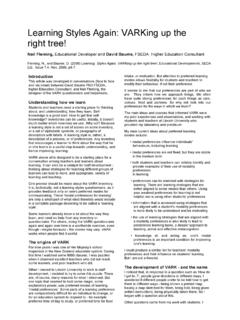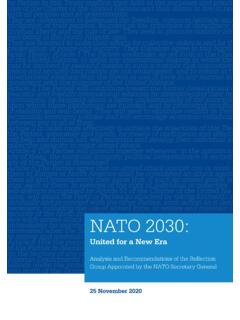Transcription of Not Another Inventory - VARK
1 Not Another Inventory , Rather a Catalyst for Reflection From To Improve the Academy, Vol. 11, 1992., page 137 Neil D. Fleming Lincoln University, Canterbury, New Zealand Colleen Mills Lincoln University, Canterbury, New Zealand In this article the authors focus on the use of a modal preferences questionnaire as a catalyst to empower students to reflect on their own sensory preferences and modify their study methods accordingly. The authors discuss the development and use of the questionnaire, strategies for students to use in modifying their learning behavior, responses of students and faculty to the technique, and directions for further investigation of modal preferences. Over the last four decades the literature from both psychology and education has supported the proposition that learners of all ages have different yet consistent ways of responding in learning situations.
2 These behaviors or predispositions to behave in a particular fashion have been termed learning styles (Claxton & Ralston, 1978; Grasha, 1990; Price, 1983) or cognitive styles (Goldstein & Blackman, 1978; Knox, 1977; Witkin & Goodenough, 1982). Research has spawned a wide range of inventories with which to assess the various style dimensions that have been identified ( , Canfield & Lafferty, 1974; Dunn, Dunn, & Price, 1987; Honey & Mumford, 1982; Kolb, 1984). Smith (1982) reviews fifteen such instruments for identifying learning styles. These measurement tools tend to focus on a collection of style dimensions to provide a profile of a learner s style. 'Me implications for teachers of the stylistic variation present in groups of learners has been discussed extensively in the literature (Cronbach & Snow, 1977; Hiemstra & Sisco, 1990; Kirby, 1979; Kogan, 1971; Martens, 1975; Messick, 1970; Schmeck, 1988; Tennant, 1988).
3 Much has been writtenonthedesimbilityofmatchingteachin gmethodstostudents'leaming styles (Conti, 1985; Cronbach 1977; Faurier, 1984). If we assume that the matching of presentational style and learner styles is a desirable objective, teachers face an incredibly demanding task. 'Me range of style dimensions and therefore the combinations that might occur in one particular student group arc likely to be so extensive that teachers arc unable to extend their repertoire of teaching methods to encompass all of them (Mills, 1989). Our collective observational experiences as teacher trainers and as an inspector of secondary schools in over 8000 classrooms during the last nine years have reinforced our belief that it is simply not realistic to expect teachers to provide programs that accommodate the learning style diversity present in their classes, even if they can establish the nature and extent of that diversity.
4 We have come to the conclusion that the most realistic approach to the accommodation of learning styles in teaching programs should involve empowering students through knowledge of their own learning styles to adjust their learning behavior to the learning programs they encounter. This suggestion is not to say that we believe teachers should not consider the learning styles when developing and delivering instructional program. Rather, we believe in assisting students to know themselves and to operate in a metacognitive fashion to make adjustments in their learning behaviors (Biggs, 1987; Flavell, 1976). Students arc in no better position than their teachers to understand and assess the wide range of dimensions that collectively form an individual's learning style. The literature is too extensive and provides limited assistance in determining which particular dimensions need to be addressed to gain a complete or at least comprehensive understanding of the nature of learning style.
5 We therefore looked for a dimension of learning style that had some degree of pre-eminence over other dimensions. By questioning students, we found that many students attributed their learning difficulties to the form in which course material was presented. Some students found they had difficulties learning in situations where the course material was only presented orally, while others reported similar difficulties when the material was primarily in written form. Still other students experienced difficulty with ideas that were presented in graphics or without any associated concrete experiences. These insights prompted us to focus on sensory modality as a learning style dimension that had some pre-eminence over others. 'Me notion that tile way information is initially taken in by a learner influences what subsequently occurs has intuitive appeal.
6 We found support for this notion in literature on neuro-linguistic programming (NLP) (Bandier, 1976,.1979; McLeod, 1990; Stirling, 1987) that discussed the different perceptual modalities (aural, visual, and kinesthetic). The following questions were suggested from our exploration of this field of study, split-brain research (Gazzaniga, 1973; Sperry, 1973; Springer & Deutsch, 1985) and left brain/right brain modalities (Buzan, 199 1; Edwards, 1979): How can students be encouraged to reflect on the nature, extent and implications of their sensory modalities? As a consequence of exploring their sensory modality preference, will students modify their existing learning strategies in ways that assist their learning? Our experience with the administration of learning style inventories did not encourage us to believe that the use of an Inventory was going to be the most effective way of encouraging students to reflect upon their sensory modality preferences.
7 We knew that students often found inventories tedious to complete and at times difficult to respond to because of their generality. Many inventories also lacked supportive strategies to assist students after they had been diagnosed. Students usually fell into two categories: those who enjoyed ascribing labels to their behavior and those who were suspicious of any measure that claimed to be able to establish that they behaved in predictable ways. Our attention therefore turned away from inventories. We sought, instead, a simple technique that would promote reflection on sensory modality and would be characterized by its brevity, simplicity, and ability to encourage students to describe their behavior in a manner they could identify with and accept. We believed that if students could be intimately involved in the process that produced a description of their own sensory modality preferences, they might be more likely to use it in subsequent learning.
8 Developing a Technique The Catalyst The first task was to design a technique that would focus students' attention on ways they address information. Rather than a simple dagnostic tool, we wanted something that would serve as a catalyst for discussion and debate and encourage students to collaborate in the process . We believed the technique had to be something that drew on common experiences and did not introduce abstract notions. A simple questionnaire was therefore devised with the questions drawn from observations students had shared, personal observations of our own modal preferences, and preferences reported by friends (Appendix A). Some of the questions were prompted by discussions of how some people can navigate better than others. Other questions came from reflecting on the ways people chose to remember or ignore different sensory cues such as shopping lists or verbal instructions.
9 Because we were seeking a quick and easy catalyst for discussion rather than an elaborate diagnostic tool, we decided that 13 questions would be adequate. In addition, we established that because the instrument would be used primarily to stimulate reflection and discussion, testing for construct validity and reliability was unnecessary and inappropriate. Although we started with Stirling's (1987) three categories of visual, aural, and kinesthetic, we found that the categories appeared to be insufficient to account for the more detailed differences we noted among students. Even though our eyes are used to taking in all visual information, the information itself differs. 'Me first preference includes diagrammatic material often used by teachers to symbolize information ( , graphs, charts, flow charts, models, and all the symbolic arrows, circles, hierarchies and other devices used by teachers to represent what could have been printed information).
10 Second, there is information that is largely composed of printed words from which some students appear to get a greater or lesser degree of understanding. Although both use the visual sense, for the purposes of the questionnaire, this visual preference was divided into two perceptual modes: 1. Visual (V) preference for graphical and symbolic ways of representing information. 2. Read/Write (R) preferences for information printed as words. The third perceptual mode, aural (A), describes a preference for "heard" information. Students who prefer aural forms of information dissemination report that they learn best from lectures, tutorials, and discussion with other students and faculty. The fourth perceptual mode, kinesthetic (K), provides some difficulties because it is multi-modal and because of the different ways in which the word is used.





